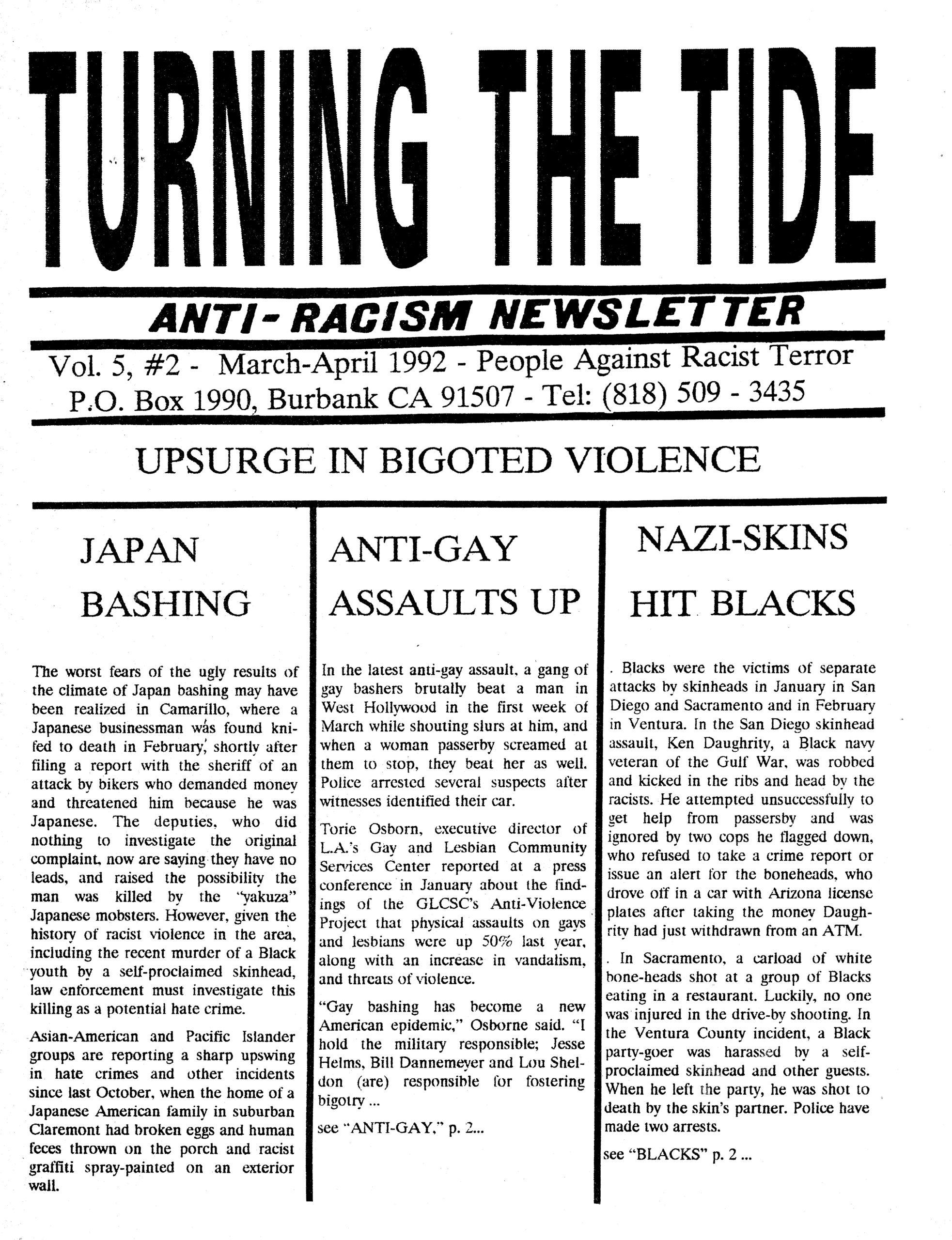Vol. 5, #2, March-April 1992

U.S. MEXICO BORDER SITE OF INTENSIFIED REPRESSION
by Michael Novick
An intensification of Border Patrol and INS activity by new U.S. Attorney General William Barr, along with the completion of a high fence along much of the San Diego-Mexico border, has resulted in increased tensions along the border. The border fence, touted as a druginterdiction measure, has helped produce a 23% increase in arrests by the Border Patrol in the area last year, to over 540,000. It has also served to funnel migrant workers into a few zones. In a highly publicized development earlier this year, undocumented border crossers were organized to sweep across into the U.S. via the southbound lanes of the main road into Mexico from San Diego. Nicknamed the “Border Swarm,” this tactic elicited an immediate response from the INS, which threatened to narrow the approach to Tijuana on Interstate 5 to two lanes on the U.S. side. This threat was meant to provoke the Mexican government to action, by curtailing the flow of U.S. shoppers and tourists unless Mexican immigration authorities clamped down on the new tactic by the “coyotes” who bring undocumented workers across. The threat had the desired effect, and the dangerous runs into oncoming traffic have stopped.
But the Border Patrol continues to chase vehicles suspected of bringing aliens into the U.S. Several people have died in the chases; in the most recent one, which led into Orange County, two civilians used their vehicles to block a car being chased. More traffic fatalities have also been recorded near the INS checkpoint on the interstate.
The Border Patrol has assigned 300 new officers to the area, and 200 new INS investigators have been hired. To supplement surplus military equipment and vehicles that have been supplied to the Patrol by the Defense Department, the INS’s asset forfeiture fund has been tapped for $5 million to add new lights, sensors and other surveillance equipment.
This militarization of the border has not been restricted to CA. Late last year, Marines from the massive Camp Pendleton base in the area were sent to do reconnaissance along the border in New Mexico, allegedly to provide support to drug interdiction efforts by local law enforcement.
While cutting out all funds that were promised for the provision of educational and health services for newly legalized residents under the Immigration Reform and Control Act, Pres. Bush’s budget proposal calls for an increase of almost $100 million in the funding for the INS over this year, to a total of well over $1 billion. Roger Diaz de Cossio, a Mexican Foreign Ministry official, characterized the moves as “a reflection of the U.S. economic crisis,” typical of the pattern in which Mexican migrant workers are scapegoated during periods of economic downturn in the U.S.
The Mexican response was echoed by immigration rights activists in the U.S. In a report issued in late February, the American Friends Service Committee, which runs a Mexico-U.S. Border Program, documented hundreds of immigration-related abuses in five border areas in California, Texas and Florida over the last two years. The report, the group’s third, registered a decline since the height of complaints during the amnesty program but still found “significant and serious abuse.” Maria Jiminez of the AFSC said that the study showed that Barr’s carckdown would only “result in still higher levels of abuse,” unless needed reforms were undertaken. In particular, the group called for the establishment a civilian review agency to oversee complaints against the enforcement practices of ‘la Migra.’
According to Roberto Martinez of the AFSC Border Project in San Diego, the report also criticized the death of three Mexicans during the period in traffic accidents resulting from car chases by the INS. Steve Kean, a Border Patrol spokesman, rejected the charges. “The smuggler who causes the chase should be held responsible (not the Border Patrol),” he told the L.A. Times, also rejecting the call for civilian review. The Justice Department reviews allegations of misconduct by INS agents. One such case of INS misconduct, that of James Riley, an immigration officer based in L.A., resulted in his conviction on a charge of false imprisonment, while being acquitted on 18 counts of rape. Jurors chose to discount the testimony of half a dozen undocumented Latinas who came forward to charge that he had used the threat of deportation to force them to have sex with him.
The crackdown on the border comes in the context of stalled negotiations on the U.S.-Mexico free trade agreement. In another border initiative aimed at making the treaty more palatable in the U.S., Bush announced an environmental initiative for the highly-contaminated border zone. The measure, announced jointly by the Mexican government, would provide for an international sewage treatment plant for Tijuana and San Diego. During California’s recent torrential rains, sewage spills from L.A. down to Tijuana closed hundreds of miles of beaches in the state and in Mexico’s Baja California peninsula. The pipeline that carries San Diego’s barely treated sewage out to sea where it can be diluted ruptured in 15 places right near the shoreline and dumped human wastes into the shallow waters at the rate of millions of gallons a day.
Meanwhile, opposition to the trade pact is mounting from quarters that fear it will actually intensify emigration to the U.S. from Mexico, as upwards of 500,000 Mexican farm-workers are displaced from agricultural employment in their own country as the proposed pact eliminates Mexican subsidies for its corn industry and opens Mexican agriculture to investment and mechanization by U.S. agribusiness interests. Immigration rights activists believe that the problem will never be solved so long as economic underdevelopment drives Mexicanos north, and the U.S. labor market simultaneously seeks such low-waged, easily exploitable workers.
